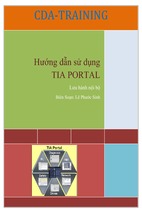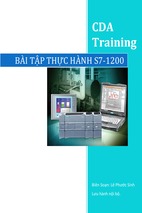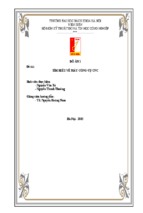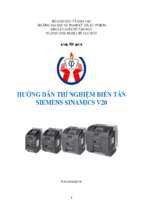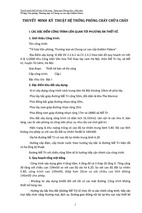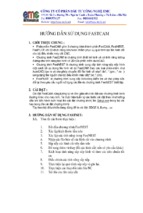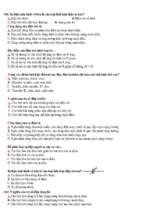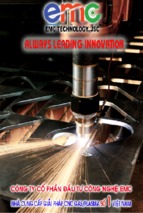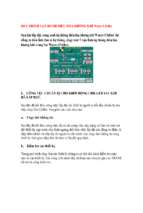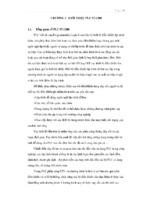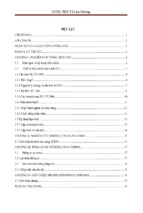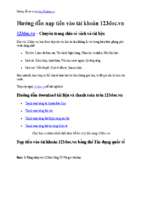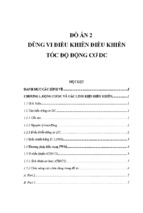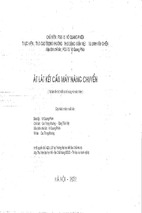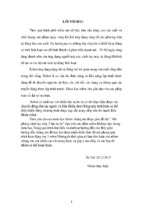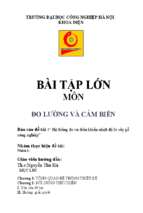TIME MEASUREMENT
&
PROCESS OPTIMIZATION
DIGITAL LOCK ASSEMBLY LINE - FISCHER ASIA CO., LTD.
WORK PROJECT
Team B:
Nguyen Thi Thu HIEN
Ngo Phuoc LOC
Huynh Truong LY
Le Hoang NHAN
Supervisor: Dr.-Ing. Marlene Helfert, Technical University of Darmstadt
Binh Duong, 2016.11.20
2016-11-20
0
Abstract
This project examined digital lock assembly processes at Fischer Asia Co. Ltd., a
German company specializing in stamping and shaping processes for all kinds of metal
products.
REFA time study method is used to record and analyze time data of each working process, and
line balancing and Lean management are applied to propose optimal improvement models.
After analyzing actual processing time, time spent for waiting and additional activities of
current workstations and line balancing, the assembly line has been optimized from ten
to six workstations, the average percentage of waiting time, almost 14% reduces to
7.62% and we propose new short-term and future layouts after improvements.
This project will contribute to future research into time studies on other processes in
Fischer Asia Co., Ltd. in particular and manufacturing factories in general.
2016-11-20
1
Table of contents
Abstract .........................................................................................................................1
Table of contents ...........................................................................................................2
List of figures .................................................................................................................3
List of tables ..................................................................................................................3
1.
Introduction ............................................................................................................3
2.
Measurement .........................................................................................................3
2.1.
Method ............................................................................................................3
2.2.
Result..............................................................................................................4
2.2.1.
Workstation 3 ...........................................................................................4
2.2.2.
Workstation 4 ...........................................................................................6
2.3.
2.3.1.
Workstation 3 ...........................................................................................7
2.3.2.
Workstation 4 ...........................................................................................7
2.4.
3.
Discussion.......................................................................................................7
Conclusion ......................................................................................................8
2.4.1.
Workstation 3 ...........................................................................................8
2.4.2.
Workstation 4 ...........................................................................................8
Optimization ...........................................................................................................8
3.1.
Method ............................................................................................................8
3.2.
Current situation ..............................................................................................9
3.3.
Improvement suggestions .............................................................................10
3.3.1.
Combination of workstation 5 and workstation 6 ....................................10
3.3.2.
Reduction of processing time of workstation 9 .......................................11
3.3.3.
Assignment of more tasks to workstation 1 ............................................12
3.4.
Result............................................................................................................13
3.5.
Discussion.....................................................................................................13
3.6.
Conclusion ....................................................................................................14
3.6.1.
Short-term layout....................................................................................14
3.6.2.
Long-term layout ....................................................................................15
4.
Reference ............................................................................................................15
5.
Appendix ..............................................................................................................16
2016-11-20
2
List of figures
Figure 1. Current processing time of ten workstations
Figure 2. Processing time of seven main workstations before improvement
Figure 3. Processing time of production line after combining workstation 5 & 6
Figure 4. Current processing time of Workstation 9 and 10
Figure 5. Processing time of Workstation 9 and 10 after balanced work
Figure 6. Compared processing time of workstation 1 before and after work assignment
Figure 7. Processing time of production line after improvement
Figure 8. Short-term layout after line balancing
Figure 9. Long-term layout after improvement
List of tables
Table 1: Normal time of processing activity of workstation 3
Table 2: Total share of time spent for each activity of workstation 3
Table 3: Normal time of processing activity of workstation 4
Table 4: Total share of time spent for each activity of workstation 4
Table 5. Compared average percentage of waiting time and manpower
1. Introduction
This report discusses work and time studies to analyze the types of time spent for
operator’s activities of workstations in an assembly line of a digital lock product. The
objective of the studies is to establish normal time used for increasing the efficient work
facilities utilization as well as personnel performance, and to recommend optimization
proposals for assembly processes. The report presents the method of work and time
studies, the results, the analysis of those results and the process optimization.
2. Measurement
2.1. Method
The digital lock assembly line currently includes ten workstations [Appendix 3], in which
some workstations carry out same processes, for instance, workstation 2 and
workstation 9, workstation 3 and workstation 8, workstation 4 and workstation 7.
2016-11-20
3
Our team focused on measuring time of workstation 3 and workstation 4, which were
broken down into small processes, by using stopwatch time study method and data were
recorded in REFA sheet Z2 [Appendix 1, Appendix 2].
Fifteen measurements of activities per each process were collected, and the
measurements of interruption of activity, additional activities as well as unforeseen tasks
were also observed and recorded during the studies..
2.2. Result
According to the measured actual time, normal time (ti) is calculated based on
performance factor (L) and actual measured time (ti).
In addition, total share of time spent for processing time, waiting time, additional activities
and getting and/or searching parts are counted.
2.2.1.
Workstation 3
Table 1: Normal time of processing activity of workstation 3
Process
name
Process
description
Normal
Relative
time - ti confidence
(second) level
Put
motor Reach for motor, fold
into shaft
wire, put motor into
shaft
Min real Max real
value
value
(second) (second)
12.84
10.16%
11.54
14.15
6.23
28.37%
4.46
8.00
5.32
9.78%
4.80
5.84
8.84
15.98%
7.43
10.25
Release motor
Add
sprocket
Reach for sprocket
and put it on motor
Release sprocket
Grease
Reach for brush,
grease locking block
holder
Release brush
Add locking Reach for prepared
block
locking block, add it
on locking block
holder
Release
block
2016-11-20
locking
4
Add slider
Reach for slider, add
it on sprocket
5.50
15.41%
4.65
6.35
8.79
17.88%
7.22
10.36
Release for slider
Fold board
Reach board, fold it
Release board
Total processing time per cycle
47.53
Table 2: Total share of time spent for each activity of workstation 3
Activity
Put motor in shaft
Normal time
Time share
- ti (second)
of activity
192.60
23.11%
Add sprocket
93.45
11.21%
Grease lubricant
79.80
9.57%
Add locking block
132.60
15.91%
Add slider
82.50
9.90%
Fold board
131.10
15.82%
Total share of processing time
712.95
85.52%
-
-
46.20
5.54%
-
-
74.50
8.94%
-
-
Total share of waiting time
Total
share
of
time
spent
for
getting/searching parts
Total share of time spent for personal
allowances
Total share of time spent for additional
activities
Others
2016-11-20
5
2.2.2.
Workstation 4
Table 3: Normal time of processing activity of workstation 4
Process
name
Process
description
Normal
Relative
time - ti confidence
(second) level
Put housing Reach for housing
in assembly from box, put it on
box
assembly
box,
check position
Min real Max real
value
value
(second) (second)
3.31
14.32%
2.84
3.78
23.74
10.73%
21.19
26.29
3.51
13.31%
3.04
3.98
3.62
13.95%
3.11
4.13
3.31
17.55%
2.73
3.89
Release housing
Add buttons
Reach for 7 buttons
from the box, add
them on housing
Release buttons
Add support Reach for support
grid
grid from box, add
on 7 buttons in the
rights side
Release
grid
support
Add
main Reach for main
board and board from box,
fix it
add on support grid
with the right side
for led operation
Release board
Add battery Reach for battery
holder
holder from box,
add on board.
Release
holder
battery
Total processing time per cycle
2016-11-20
37.49
6
Table 4: Total share of time spent for each activity of workstation 4
Activity
Put housing in assembly box
Normal time -
Time share of
ti (second)
activity
49.65
6.81%
356.10
48.86%
Add support grid
52.65
7.22%
Add board and fix it
54.30
7.45%
Add battery holder
49.65
6.81%
562.35
77.15%
40.00
5.49%
-
-
52.50
7.20%
74.50
10.15%
-
-
Add all buttons
Total share of processing time
Total share of waiting time
Total
share
of
time
spent
for
getting/searching parts
Total share of time spent for personal
allowances
Total
share
of
time
additional activities
Others
spent
for
2.3. Discussion
2.3.1.
Workstation 3
Table 1 shows the processing time of 47.53 seconds which was slightly greater than the
number of workstation 8 which implemented same processes (38.80 seconds)
[Appendix 3]. Because the operator was quite new with these processes, so she spent
quite long time in readjusting parts after each process [Appendix 1].
The operator spent 5.54% total share of time spent for getting parts from store and 8.94%
total share of time spent for rework and transfer of products from workstation 4 to
workstation 2 [Appendix 1].
2.3.2.
Workstation 4
Workstation 4 spent 37.49 seconds of processing time as compared to 44.23 seconds
of workstation 7 because workstation 4 didn’t implement the removal of battery holders
out of plastic cover (8.60 seconds) [Appendix 3]. However, if the time for that process
could be added to workstation 4, the estimated processing time of workstation 4, 46.09
2016-11-20
7
seconds, would be a little bit higher than that of workstation 7 (44.23 seconds). It would
be because the operator was not experienced with all processes.
At the beginning of the task, the operator had to wait in 40 seconds for getting housing
from workstation 7.
The operator usually spent approximately 2 seconds for adjusting the position of
assembled housing after every completion of the last process.
The operator spent 52.50 seconds for her small break during her task.
2.4. Conclusion
Due to long processing time and much time spent for additional and waiting activities,
some recommendations have been provided as followings.
2.4.1.
Workstation 3
The operator should be given more training in order to increase her performance, reduce
processing time of each process, and eliminate additional activity of reworking defective
products
Due to current bad layout [Appendix 4], the operator spent much time to transfer preassembled main housings from workstation 4 to workstation 2 which was her additional
activity, so the working position of this operator must be re-located to cut down this
additional activity.
Material supply system should be established so that this operator’s time spent for
getting raw materials are completely rejected.
2.4.2.
Workstation 4
The operator should be trained to minimize her additional activities of adjusting holder
position after finishing the final process as much as possible and to get performance as
good as the operator who worked at workstation 7.
3. Optimization
3.1. Method
Line balancing method was used to analyze activities of ten workstations.
Re-designing layout of assembly line by process layout method and Lean management
to cut down wastes in production line.
2016-11-20
8
Workflow between every workstation was recorded and drawn in current layout
[Appendix 4].
3.2. Current situation
Figure 1. Current processing time of ten workstations
Workstation 2, 3, and 4 are temporary in production line during observation time. The
processes of those workstations are similar to workstation 9, 7 and 8 respectively
[Appendix 3]. In order to ensure line balancing, these three momentary workstations
are not be considered and are cut down in production line, therefore, the assembly line
consists of seven main workstations [Figure 2].
2016-11-20
9
Figure 2. Processing time of seven main workstations before improvement
From Figure 2, workstation 9 has the highest processing time, 45.41 seconds, while the
lowest processing times are at workstation 1 and 5, 12.40 and 14.32 respectively. The
next section will focus on these workstations in order to balance processing time.
3.3. Improvement suggestions
3.3.1.
Combination of workstation 5 and workstation 6
Figure 3. Processing time of production line after combining workstation 5 & 6
2016-11-20
10
Workstation 5 soldered wires on motor and workstation 6 carried out soldering board on
motor while both workstations used same work facilities. For this reason, we suggest
that they should be merged into one workstation which is implemented by only one
operator. It reduces one workstation and one operator.
The estimated total processing time after improvement is 36.71 seconds.
3.3.2.
Reduction of processing time of workstation 9
Figure 4. Current processing time of Workstation 9 and 10
Figure 4 shows processing time of each process in workstation 9 and 10. Workstation 9
included “Check buttons” process which utilized 7.03 seconds while workstation 10 spent
waiting time of 13.24 seconds during laser marking machine was operated.
We propose the process of checking buttons should be transferred to the waiting process
of laser marking at workstation 10. That means while the laser marking machine is doing
coding, the operator does checking buttons by using battery.
Thus, the estimated processing time of workstation 9 reduces from 45.41 seconds to
38.38 seconds while the total share of processing time of workstation 10 still remains
unchanged (30.57 second) [Figure 5].
2016-11-20
11
Figure 5. Processing time of Workstation 9 and 10 after balanced work
3.3.3.
Assignment of more tasks to workstation 1
Figure 6. Compared processing time of workstation 1 before and after work
assignment
Workstation 1 implemented putting spring into locking block which has used the lowest
processing time, 12.40 seconds. Thus, we recommend this workstation should be
assigned more tasks such as doing reworks of defective products or supplying materials
to other workstations during her waiting time. We assume the time spent for doing
reworks and for supplying materials is 23.00 seconds, on average, so the estimated
2016-11-20
12
processing time of this workstation after improvement is 35.40 seconds which is utilized
effectively.
3.4. Result
Figure 7. Processing time of production line after improvement
Table 5. Compared average percentage of waiting time and manpower [Appendix 6, 7]
Item
Before improvement
Average waiting time (%)
Manpower
After improvement
13.99%
7.62%
10
6
3.5. Discussion
Workstation 1 and new workstation are considered as pre-assembly line, so the main
assembly line has four remaining workstations. After improvement, the processing time
of each workstation is more balanced. There are very small fluctuations in time values
among workstations, from nearly 30 seconds at least to almost 39 seconds [Figure 7].
With the tact time of 38.80 seconds, the mean percentage of waiting time in main
production line after balancing is 7.62% as opposed to before improvement of
approximately 14%, on average [Table 5].
Before improvement, ten operators take part in ten workstations [Appendix 3], but after
line balancing, the assembly line has only six workers working at six workstations
[Appendix 5].
2016-11-20
13
3.6. Conclusion
From six workstations in Figure 7, we suggest that the layout of assembly line should be
re-arranged so that worker’s tasks are much easier to be done, and the distance of
moving materials and semi-products are shortened as much as possible. We propose
two layouts which can be used in short term and in future, and we analyze the benefits
and drawbacks of both layouts for virtual application.
3.6.1.
Short-term layout
Figure 8. Short-term layout after line balancing
In short-term layout, the pre-assembly area is established including two workstations.
The first workstation, which carries out putting spring into locking block, is located next
to new soldering workstation. The main assembly line is unchanged as compared with
the current layout [Appendix 4]. However, each operator in this line must follow new
arranged works as line balancing [Appendix 5].
Advantage:
●
Pre-assembly processes is moved to separated area
●
Simple improvement and able to apply immediately
Disadvantage:
●
Long distance of movement between pre-assembly area and main assembly
area.
2016-11-20
14
3.6.2.
Long-term layout
Figure 9. Long-term layout after improvement
The purpose of long-term layout is to provide permanent solutions for the manufacturing
process of digital lock. Two tables are rearranged closely in the middle of room.
Operators sit face-to-face and transfer semi-product directly to others on surface’s table.
Advantages:
●
Shorter distance of movement between pre-assembly line and main production
line.
●
Workflow is smoother and easier to control.
Disadvantage:
●
Need more time to set-up facilities: pneumatic system, electricity, vacuum
machine.
●
Design new table of production line and tray to keep components don’t fall out
●
Need to consider flexibility of changeover ability between different products.
4. Reference
http://p7883.mittwaldserver.info/en/home/
Dr.-Ing. Marlene Helfert (2016), Work and Time studies, Technical University of
Darmstadt
Liker, Jeffrey K. (2004). The Toyota Way: 14 Management Principles from the World's
Greatest Manufacturer. McGraw-Hill. ISBN 978-0-07-139231-0.
2016-11-20
15
5. Appendix
Appendix 1: REFA sheet Z2-Workstation 3
Nr.
1
Workstation 3
Ref.
quant.
Zy
mz
Unforeseen task
(Transfer
products
from
workstation 4 to workstation 2)
1
L
ti
Release pre-assembly
board
Put motor in shaft
2
main
F
Release motor & shaft
Add sprocket
Release sprocket
Grease lubricant
Release brush
Add locking block
Release locking block
Add slider
2016-11-20
19.0
6
7
8
9
10
11
12
13
14
15
23.5
19
∑L/n
∑ ti / n
L
ti
t=
L
100
ti
42.50
42.50
42.50
328
L
ti
F
100
100
100
105
105
90
100
115
60
80
100
110
90
100
100
15
13.0
12.6
12.8
11.9
11.3
14.5
12.2
9.1
20.1
16.9
13.6
10.1
14.6
12.6
13.3
198.59
32
116
175
230
276
343
412
449
500
601
648
690
736
784
831
15
L
ti
F
70
80
60
90
100
30
100
105
105
105
90
100
70
105
100
15
8.0
7.1
10.8
6.9
5.8
20.1
5.4
4.4
4.8
4.4
6.4
5.0
8.2
4.3
5.6
107.01
40
123
186
237
282
363
417
453
505
606
654
695
744
789
836
15
L
ti
F
95
100
100
95
100
95
105
90
105
105
100
100
105
90
100
15
6.0
5.0
4.9
6.2
4.6
6.7
4.2
7.2
4.4
4.9
5.3
4.9
4.2
7.3
5.0
80.61
46
128
191
243
287
370
421
460
509
611
659
700
748
796
841
15
L
ti
F
100
60
80
100
105
80
100
105
105
90
105
110
100
105
100
15
9.0
17.8
11.5
8.5
7.7
12.1
8.4
7.2
7.5
10.5
7.3
6.0
8.3
7.1
8.9
137.66
55
145
203
251
294
382
430
467
517
621
667
706
756
803
850
15
L
ti
F
100
60
105
100
100
105
110
100
105
105
105
100
105
70
105
15
6.0
10.6
4.6
5.7
5.9
4.4
3.9
5.8
4.8
4.5
4.8
5.5
4.7
8.1
4.6
83.91
61
156
207
257
300
386
434
473
521
626
672
711
761
811
855
15
1475.00
1
Release slider
5
1445.00
1
6
4
1485.00
1
5
3
1310.00
1
4
2
1455.00
1
3
1
97.00
12.84
13.24
87.33
6.23
7.13
99.00
5.18
5.37
96.33
8.84
9.18
98.33
5.50
5.59
16
Nr.
Workstation 3
Ref.
quant.
Zy
mz
2
3
4
5
6
7
8
9
10
11
12
13
14
15
80
125
80
105
120
60
125
125
60
100
100
90
80
120
100
15
10.0
6.7
10.9
7.9
4.5
13.5
5.8
6.7
16.9
8.4
8.4
9.5
10.7
6.4
8.3
134.57
71
163
218
265
305
400
440
480
538
634
680
721
772
817
863
15
Fold board
7
8
1470
1
Release board
Unforeseen task
(Readjust folded board, get
motors from store)
End of unforeseen task
2016-11-20
∑L/n
∑ ti / n
1
L
ti
F
L
ti
F
32.0
46.2
78.20
103
585
2
L
ti
t=
L
100
ti
98.00
8.79
8.97
39.10
39.10
17
Appendix 2: REFA sheet Z2-Workstation 4
Nr.
Workstation
4
Ref.
quant.
Put housing in assembly
box
1
Release housing
Add all buttons
Release last button
Add support grid
Release support grid
Add board and fix it
Release board
Add battery holder
6
7
End of interrupted activity
2016-11-20
5
6
7
8
9
10
11
12
13
14
15
L
ti
F
95
85
100
100
100
105
110
90
120
105
120
85
75
105
100
15
3.7
4.3
3.4
3
3.1
2.9
2.4
3.9
2
2.9
2.1
4.3
5.6
2.9
3.3
49.80
3.7
110.3
149
193
233
287.1
327
362
403
448
482
528
625
663
699
15
L
ti
F
85
100
90
95
90
90
105
100
100
100
100
100
100
105
80
15
32.1
22.7
28.2
24.3
29.8
27.3
19.2
21.1
21.3
21.5
22.0
22.1
22.1
19.6
37.7
371.00
35.8
133
177
217
263
314
346
384
424
469
504
550
647
683
736
15
L
ti
F
85
95
75
80
95
100
95
80
85
115
100
105
110
90
105
15
4.3
3.5
5.7
4.9
3.7
3.2
3.8
4.8
4.3
2.1
3.1
2.8
2.6
4.1
2.9
55.80
40.1
137
182
222
267
318
350
388
428
471
507
553
650
687
739
15
L
ti
F
95
90
115
105
100
105
100
90
95
100
95
95
70
110
80
15
3.9
4.2
2.2
2.9
3.5
2.8
3.4
4.2
3.7
3.6
3.7
3.8
6.3
2.7
5.4
56.30
44
141
185
225
270
320
354
393
432
475
511
557
656
690
745
15
L
ti
F
75
90
105
100
100
110
100
100
115
100
115
115
110
100
100
15
6.4
4.4
3.0
3.6
3.5
2.3
3.3
3.3
2.0
3.4
2.0
2.1
2.4
3.5
3.4
48.50
50.4
145
188
228
274
323
357
396
434
478
513
559
658
693
748
15
1535
1
Release battery holder
Waiting
(Wait
for
housing
transferred
from
workstation 7)
End of waiting
Interruption
due
to
personal reason
(Personal break)
4
1445
1
5
3
1415
1
4
2
1440
1
3
∑L/n
∑ ti / n
1
1495
1
2
Zy
mz
L
ti
L
ti
F
40.0
40.00
90.4
15.6
10.5
4.8
10.8
10.8
106.0
284.2
400.6
445
524
52.50
L
100
ti
99.67
3.31
3.32
96.00
23.74
24.73
94.33
3.51
3.72
96.33
3.62
3.75
102.33
3.31
3.23
L
ti
F
t=
40.00
40.00
52.50
52.50
18
Nr.
8
Workstation
4
Unforeseen task
(Readjust added battery
holder)
End of unforeseen task
2016-11-20
Ref.
quant.
Zy
mz
L
ti
F
1
2
3
4
2.1
190
5
6
7
1.7
2.1
1.6
230
325
359
8
9
10
11
12
13
14
1.8
60.5
2
2.2
480
619
660
695
15
∑L/n
∑ ti / n
74.00
L
ti
t=
L
100
ti
74.00
74.00
19
- Xem thêm -

